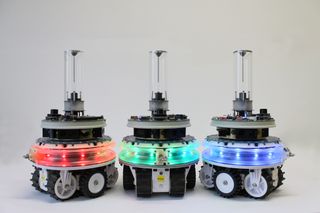Assemble! 'Voltron'-Like Robots Can Elect Their Own Leader
With a nod to the "Voltron" Defender of the Universe" — the animated show in which five lion-shaped robots link up to form a giant machine that fights evil — a team of scientists has created robots that work together and decide which one will lead them.
Typically, if a robot's "brain" (or central processor) gets damaged or destroyed, the machine must take a trip to the great robot repair shop in the sky (or technician's bench).
However, a team led by Marco Dorigo, who heads a robotics lab at the Free University of Brussels, built a robot of sorts that has a fallback, or fallbacks: These robots can link up, react to their environment and delegate authority to a single member of a group. They can add new robots and merge groups, and if the leader of the robots is damaged (or its battery runs out), the other robots can pick a new leader and continue with a task. [Super-Intelligent Machines: 7 Robotic Futures]
"It's like a bunch of people gathering to build a house," Dorigo told Live Science. "Everyone knows approximately what to do, but if there's no structure, no hierarchy, building a house is difficult." These new robots create their own hierarchies; they choose one to be the leader, which can direct the others.

The robots can also link up so that they can accomplish tasks that they couldn't complete by themselves. The team demonstrated one robot that, in order to lift a brick, had to connect with another robot that had arms.
Robots that work in unison aren't unusual; flying drones can dance together and rebuild their formations when one is missing. The difference is that those drones often operate in a preprogrammed way, using their ability to sense their positions when creating their formations, Dorigo said. Thus, they have a limited ability to adapt, he said.
These Voltron-like robots, on the other hand, can (by linking up) create a kind of nervous system, deciding which one will be the brain (called the parent by the researchers) and which will be the limb (called the child). This arrangement allows the group to adapt to new conditions. In one video, one robot stops functioning and the others choose a new leader, which will be the brains of the system. (The robots know their leader has stopped working because it doesn't acknowledge signals from the others.)
Sign up for the Live Science daily newsletter now
Get the world’s most fascinating discoveries delivered straight to your inbox.
This brain-children setup works because the robots all have an internal map of the others that are connected to them, and that map looks like a hierarchical tree, said Nithin Mathews, lead author of the paper describing the work. When the lead robot stops working, the others can see where in the tree they are; those closer to the "root" are more likely to be chosen as leads.
It can also be environment-dependent. For example, if a bunch of robots were near some resource they needed, the closest one to that resource would take over as the head.
Further, when two groups of robots join together, the leader of the first group can transfer its internal map of the other robots to the leader of the second group, giving up the leadership position and becoming part of the now-larger group.
Mathews said the architecture was in part inspired by slime molds, which are simple organisms that join together to behave as a kind of super-organism. The robots work in a similar fashion, he said. "Slime mold can come together as single body, but the nervous system is missing," Mathews said. "Higher-order animals have nervous system with single brain unit. We thought, 'Lets bring these worlds together.'"
While the robots used so far are very simple — they are just wheeled carts smaller than a Roomba vacuum — the achievement suggests that robots can be trained to adapt as a group to new environments, Mathews said. Further, they can even be made of many parts; imagine a robot that is using an arm (which itself is an autonomous robot) to pick up something, and the arm gets damaged. That robot could go seek a new limb.
The big obstacle, Mathews said, is that there's no standard for robots to interact. The team had to invent the language the robots used to speak to each other. "I think there will need to be a lot of intermediate steps" before such robots are common in industry, he said.
The study is detailed in the Sept 12 issue of the journal Nature Communications.
Originally published on Live Science.

Most Popular

